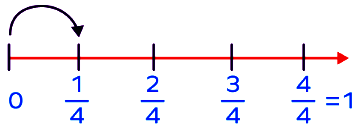Fractions in which the numerator is less than the denominator are called proper fractions. The value of a proper fraction is always less than 1.
For example, \(\frac{18}{20}\), \(\frac{19}{40}\), \(\frac{60}{80}\), \(\frac{1}{4}\),\(\frac{1}{6}\), are proper fractions.
Proper Fractions on a Number Line:
A proper fraction has a value between 0 and 1. It is a fraction that lies between 0 and 1 on a number line.
Example: Represent the proper fraction \(\frac{1}{4}\) on a number line.
To represent a proper fraction on the number line, we first look at the denominator.
This number tells us the number of parts the interval between 0 and 1 is to be divided into.
Here, the denominator is 4. Thus, we divide the segment joining 0 and 1 into 4 equal parts.

The numerator tells us where we place the dot or the mark to represent the given fraction. Here, the numerator is 1. Thus, we represent \(\frac{1}{4}\) on the first marking.

Operations on Proper Fractions
While solving problems based on complex numbers we will require the following operations.
- Addition of Proper Fractions
- Subtraction of Proper Fractions
- Multiplication of Proper Fractions
- Division of Proper Fractions
1. Addition of Proper Fractions
For the addition of any fraction, the denominator must be equal. If it is not equal, we equate it by finding the LCM for the denominator of the two fractions. Fraction on the Number Line can also be used to show addition of proper fractions.
When the denominators of two proper fractions are the same, adding the fractions is easier. Because the denominators are the same, we must sum the numerators of the fractions. For example, you can easily add 7/8 + 2/8 by adding the numerators. The sum of 7/8 and 2/8 is 9/8.
However, if the fractions’ denominators differ, we utilise the LCM (Least Common Multiple) of the denominators. We use the LCM as the common denominator to recast the fractions into comparable fractions.
To add 1/3 + 3/5, for example, we use the LCM of the denominators. 3 and 5 have an LCM of 15. Then we’ll multiply both fractions by the same number (in this case, 5 and 3) so that the denominators are the same. As a result, (5 + 15)/15 = 20/15 is obtained.
2. Subtraction of Proper Fractions
Subtracting suitable fractions is similar to combining them. We subtract the numerators while preserving the same denominator if we need to calculate the difference between two identical fractions.
As an example, For example, the difference between 5/9 and 3/9 is 2/9.
To subtract dissimilar fractions, we rewrite the fractions as equivalent fractions with the LCM as the common denominator, using the LCM of the denominators. When all the denominators are the same, we subtract the numerators and write the result on the common denominator.
To subtract 7/9 from 2/4, for example, we utilize the LCM of the denominators. The LCM of 9 and 4 is 36. We now multiply both fractions by the same number (in this case, 4 and 9) to equalize the denominators. As a result, we get (28 – 18)/36 = 10/36.
3. Multiplication of Proper Fractions
Multiplication of proper fractions is the easiest. To multiply proper fractions we must multiply the numerator with the numerator and the denominator with the denominator direct. For example, 2/3 x 3/8 = (2 x 3)/(3 x 8) = 6/24
4. Division of Proper Fractions
Dividing a fraction by another fraction is the same as multiplying the first fraction by the inverse of the second fraction. Here are the steps for the division of fractions:
Step 1: Change ÷ to × by inversing the second fraction.
Step 2: Multiply the second fraction from the first.
Step 3: Make the expression as simple as possible.
For example, 2/3 ÷ 3/8 = 2/3 x 8/3 = 16/9